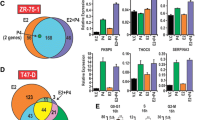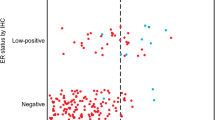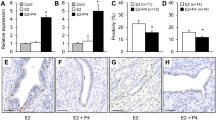Abstract
Background Estrogen receptor (ER) and progesterone receptor (PgR) protein expression carry weak prognostic and moderate predictive utility for the outcome of early breast cancer patients on adjuvant chemohormonotherapy. We sought to study the predictive significance and correlations of transcriptional profiling of the ER, PgR and microtubule-associated protein Tau (MAP-Tau) genes in early breast cancer. Materials and methods Messenger RNA (mRNA) was extracted from 279 formalin-fixed paraffin-embedded breast carcinomas (T1-3N0-1M0) of patients enrolled in the Hellenic Cooperative Oncology Group (HeCOG) trial HE 10/97, evaluating epirubicin-alkylator based adjuvant chemotherapy with or without paclitaxel (E-T-CMF versus E-CMF). Kinetic reverse transcription polymerase chain reaction (kRT-PCR) was applied for assessment of the expression of estrogen receptor, progesterone receptor and MAP-Tau genes in 274 evaluable patients. Cohort-based cut-offs were defined at the 25th percentile mRNA value for ER and PgR and the median for MAP-Tau. Results Two hundred and ten patients (77%) were ER and/or PgR-positive by immunohistochemistry (IHC). Positive ER and MAP-Tau mRNA status was significantly associated with administration of hormonal therapy and low grade, while MAP-Tau mRNA status correlated with premenopausal patient status. MAP-Tau strongly correlated with ER and PgR mRNA status (Spearmann r = 0.52 and 0.64, P < 0.001). The observed chance corrected agreement between determination of hormonal receptor status by kRT-PCR and IHC was moderate (Kappa = 0.41) for ER and fair (Kappa = 0.33) for PgR. At a median follow-up of 8 years, univariate analysis adjusted for treatment showed positive ER mRNA status to be of borderline significance for reduced risk of relapse (HR = 0.65, 95% CI 0.41–1.01, P = 0.055) and death (HR = 0.62, 95% CI 0.36–1.05, P = 0.077), while positive MAP-Tau mRNA status was significantly associated with reduced risk of relapse (HR = 0.50, 95% CI 0.32–0.78, P = 0.002) and death (HR = 0.49, 95% CI 0.29–0.83, P = 0.008). In multivariate analysis, only axillary nodal metastases (HR = 2.33, 95% CI 1.05–5.16, P = 0.04) and MAP-Tau mRNA status (HR = 0.46, 95% CI 0.25–0.85, P = 0.01) independently predicted patient outcome. However, MAP-Tau mRNA levels did not predict enhanced benefit from inclusion of paclitaxel in the adjuvant chemotherapy regimen (test for interaction P = 0.99). No correlation was evident between increasing ER and PgR mRNA transcription and increasing benefit from endocrine therapy in 203 ER and/or PgR IHC-positive patients receiving adjuvant hormone therapy (Wald P = 0.54 for ER, 0.51 for PR). Conclusions ER gene transcription carries weak predictive significance for benefit from endocrine therapy or for outcome, with no apparent dose-response association. The predictive significance is possibly exerted via MAP-Tau gene expression, an ER-inducible tubulin modulator with strong predictive significance for patient outcome. However, MAP-Tau mRNA did not predict benefit from the addition of a taxane to adjuvant chemotherapy. Further study of the biologic function and utility of MAP-Tau for individualising adjuvant therapy is warranted.





Similar content being viewed by others
References
EBCTC Group (2005) Effects of chemotherapy and hormonal therapy for early breast cancer on recurrence and 15-year survival: an overview of the randomised trials. Lancet 365:1687–1717
Bonneterre J, Thurlimann B, Robertson JFR et al (2000) Anastrozole versus tamoxifen as first-line therapy for advanced breast cancer in 668 post-menopausal women: results of the Tamoxifen or Arimidex Randomised Group Efficacy and Tolerability study. J Clin Oncol 18:3748–3757
Mouridsen H, Gershanovich M, Sun Y et al (2001) Superior efficacy of letrozole versus tamoxifen as first-line therapy for postmenopausal women with advanced breast cancer: results of a phase III study of the International Letrozole Breast Cancer Group. J Clin Oncol 19:2596–2606
Henderson IC, Patek AJ (1998) The relationship between prognostic and predictive factors in the management of breast cancer. Breast Cancer Res Treat 52:261–288
Trudeau M, Charbonneau F, Gelmon K et al (2005) Selection of adjuvant chemotherapy for treatment of node-positive breast cancer. Lancet Oncol 6:886–898
Pusztai L, Mazouni C, Anderson K, Wu Y, Symmans F (2006) Molecular classification of breast cancer: limitations and potential. Oncologist 11:868–877
Harvey JM, Clark GM, Osborne CK et al (1999) Estrogen receptor status by immunohistochemistry is superior to the ligand-binding assay for predicting response to adjuvant endocrine therapy in breast cancer. J Clin Oncol 17:1474–1481
Layfield LJ, Goldstein N, Perkinson KR et al (2003) Interlaboratory variation in results from immunohistochemical assessment of estrogen receptor status. Breast J 9:257–259
Rhodes A, Jasani B, Barnes DM et al (2000) Reliability of immunohistochemical demonstration of estrogen receptors in routine practice: interlaboratory variance in the sensitivity of detection and evaluation of scoring systems. J Clin Pathol 53:125–130
Rudiger T, Hofler H, Kreipe HH et al (2002) Quality assurance in immunohistochemistry: results of an interlaboratory trial involving 172 pathologists. Am J Surg Pathol 26:873–882
Bianchini G, Zambetti M, Pusztai L et al (2007) Use of estrogen receptor expression by quantitative RT-PCR to identify an ER-negative subgroup by IHC who might benefit from hormonal therapy. 2007 Breast Cancer Symposium; Abstract 106
Badve SS, Baehner FL, Gray R et al (2007) ER and PR assessment in ECOG 2197: comparison of locally determined IHC with centrally determined IHC and quantitative RT-PCR. 2007 Breast Cancer Symposium; Abstract 87
Gong Y, Yan K, Anderson K, Sotiriou C, Andre F et al (2007) Determination of estrogen-receptor status and ERBB2 status of breast carcinoma: a gene-expression profiling study. Lancet Oncol 8:203–211
Bhat KMR, Setaluri V (2007) Microtubule-associated proteins as targets in cancer chemotherapy. Clin Cancer Res 13:2849–2854
Fountzilas G, Skarlos D, Dafni U, Gogas H, Briasoulis E et al (2005) Postoperative dose-dense sequential chemotherapy with epirubicin, followed by CMF with or without paclitaxel, in patients with high-risk operable breast cancer: a randomised phase III study conducted by the Hellenic Cooperative Oncology Group. Ann Oncol 16:1762–1771
Landis JR, Koch GG (1977) The measurement of observer agreement for categorical data. Biometrics 33:159–174
Hudis TL et al (2007) Proposal for standardized definitions for efficacy end points in adjuvant breast cancer trials: the STEEP system. J Clin Oncol 25:2127–2132
McShane LM, Altman DG, Sauerbrei W et al (2005) Reporting recommendations for tumor marker prognostic studies. J Clin Oncol 23:9067–9072
Goldstein NS, Ferkowicz M, Odish E et al (2003) Minimum formalin fixation time for consistent estrogen receptor immunocytochemical staining of invasive breast carcinoma. Am J Clin Pathol 120:86–92
Rhodes A (2003) Quality assurance in immunohistochemistry. Am J Surg Pathol 27:1284–1285
Morris KV (2008) RNA-mediated transcriptional gene silencing in human cells. Curr Top Microbiol Immunol 320:211–224
Ravo M, Mutarelli M, Ferraro L, Grober OM, Paris O et al (2008) Quantitative expression profiling of highly degraded RNA from formalin-fixed paraffin-embedded breast tumour biopsies by oligonucleotide microarrays. Lab Invest 88:430–440
Van Maldegem F, De Wit M, Morsink F, Musler A, Weegenaar J et al (2008) Effects of processing delay, formalin fixation and immunohistochemistry on RNA recovery from formalin-fixed paraffin-embedded tissue sections. Diagn Mol Pathol Jan 28 (Epub ahead of print)
Pusztai L, Ayers M, Stec J, Clark E, Hess K et al (2003) Gene expression profiles obtained from fine-needle aspirations of breast cancer reliably identify routine prognostic markers and reveal large-scale molecular differences between estrogen-negative and estrogen-positive tumours. Clin Cancer Res 9:2406–2415
Paik S, Shak S, Tang G et al (2004) A multigene assay to predict recurrence of tamoxifen-treated, node-negative breast cancer. N Engl J Med 351:2817–2826
Symmans WF, Sotiriou C, Anderson SK et al (2005) Measurements of estrogen receptor and reporter genes from microarrays determine receptor status and time to recurrence following adjuvant tamoxifen therapy. Breast Cancer Res Treat 94(suppl 1):308a
Webb SE, Roberts SK, Needham SR, Tynan CJ, Rolfe DJ et al (2008) Single-molecule imaging and fluorescence lifetime imaging microscopy show different structures for high- and low-affinity EGFR in A431 cells. Biophys J 94:803–819
Yasuda J, Hayashizaki Y (2008) The RNA continent. Adv Cancer Res 99:77–112
Ramaswamy S, Tamayo P, Rifkins R et al (2001) Multiclass cancer diagnosis using tumour gene expression signatures. Proc Natl Acad Sci USA 98:15149–15154
West M, Blanchette C, Dressman H, Huang E, Ishida S et al (2001) Predicting the clinical status of human breast cancer by using gene expression profiles. Proc Natl Acad Sci USA 98:11462–11467
Matsuno A, Takekoshi S, Sanno N, Utsunomiya H, Ohsugi Y et al (1997) Modulation of protein kinases and microtubule-associated proteins and changes in ultrastructure in female rat pituitary cells: effects of estrogen and bromocriptine. J Histochem Cytochem 45:805–813
Jordan MA, Wilson L (2004) Microtubules as a target for anticancer drugs. Nat Rev Cancer 4:253–265
Kar S, Fan J, Smith MJ, Goedert M, Amos LA (2003) Repeat motifs of Tau bind to the insides of microtubules in the absence of taxol. EMBO J 22:70–77
Rouzier R, Rajan R, Wagner P, Hess KR, Gold DL et al (2005) Microtubule-associated protein tau: a marker of paclitaxel sensitivity in breast cancer. PNAS 102:8315–8320
Andre F, Hatzis C, Anderson K, Sotiriou S, Mazouni C et al (2007) Microtubule-associated protein tau is a bifunctional predictor of endocrine sensitivity and chemotherapy resistance in estrogen-receptor positive breast cancer. Clin Cancer Res 13:2061–2067
Rody A, Karn T, Gatje R, Ahr A, Solbach C et al (2007) Gene expression profiling of breast cancer patients treated with docetaxel, doxorubicin, and cyclophosphamide within the GEPARTRIO trial: HER2, but not topoisomerase II alpha and microtubule-associated protein tau, is highly predictive of tumour response. Breast 16:86–93
Acknowledgements
The authors wish to thank all HeCOG study coordinators for data collection, Ms. E. Fragou and Ms. D. Katsala for study monitoring, Ms. Th. Spinari for tissue sample collection and Ms. M. Moschoni for data management. Supported by HeCOG research grant HE R 10/97.
Author information
Authors and Affiliations
Corresponding author
Additional information
An invited commentary to this article can be found at doi:10.1007/s10549-008-0176-1.
George Pentheroudakis and Konstantine T. Kalogeras have contributed equally to this work.
Rights and permissions
About this article
Cite this article
Pentheroudakis, G., Kalogeras, K.T., Wirtz, R.M. et al. Gene expression of estrogen receptor, progesterone receptor and microtubule-associated protein Tau in high-risk early breast cancer: a quest for molecular predictors of treatment benefit in the context of a Hellenic Cooperative Oncology Group trial. Breast Cancer Res Treat 116, 131–143 (2009). https://doi.org/10.1007/s10549-008-0144-9
Received:
Accepted:
Published:
Issue Date:
DOI: https://doi.org/10.1007/s10549-008-0144-9




